Introduction
Tagging is the process by which business reports are made computer-readable. It involves adding tags, invisible to the human reader, to figures or narrative so that automated systems can extract the useful information from the report. The Corporate Sustainability Reporting Directive (CSRD) disclosure requirements require the use of tagged reports using the European Single Electronic Format (ESEF) also known as inline XBRL (iXBRL).
The image below shows all the computer readable information in an iXBRL tag.
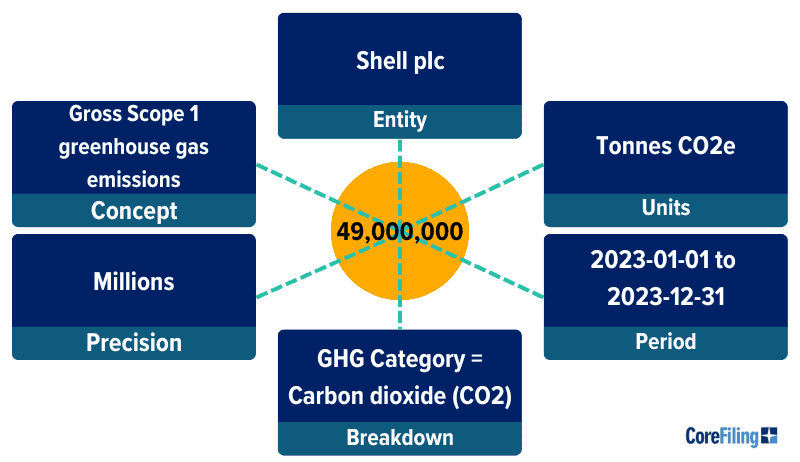
The European Single Electronic Format (ESEF)
Paper, or PDF (“digital paper”), reports have been refined over a long period of time and people have learnt to digest even quite complex layouts quickly to understand what is being communicated. The need for reports like this has not gone away because of digitisation and simply “reading” remains an important way to consume corporate reports.
On the other hand, computers do not deal with paper or PDF reports very well at all. While they look structured to a person, extracting information automatically is a major challenge. Most often, extraction on a large scale requires people to extract the data manually.
So, in 2018, the European Union (EU) decided to define a new format for business reporting that could do both – at the same time! Thus, the European Single Electronic Format (ESEF) was born.
The ESEF is part HTML, the language of the Internet and how web pages are written, and part iXBRL. iXBRL is a standard format, built on top of HTML, that allows for computer readable tags to be embedded in a report. With ESEF, we can view and read the report in a browser as normal while computers can extract the tagged information they need for automated processing. The image below shows a partially tagged report with digital tags highlighted in yellow.
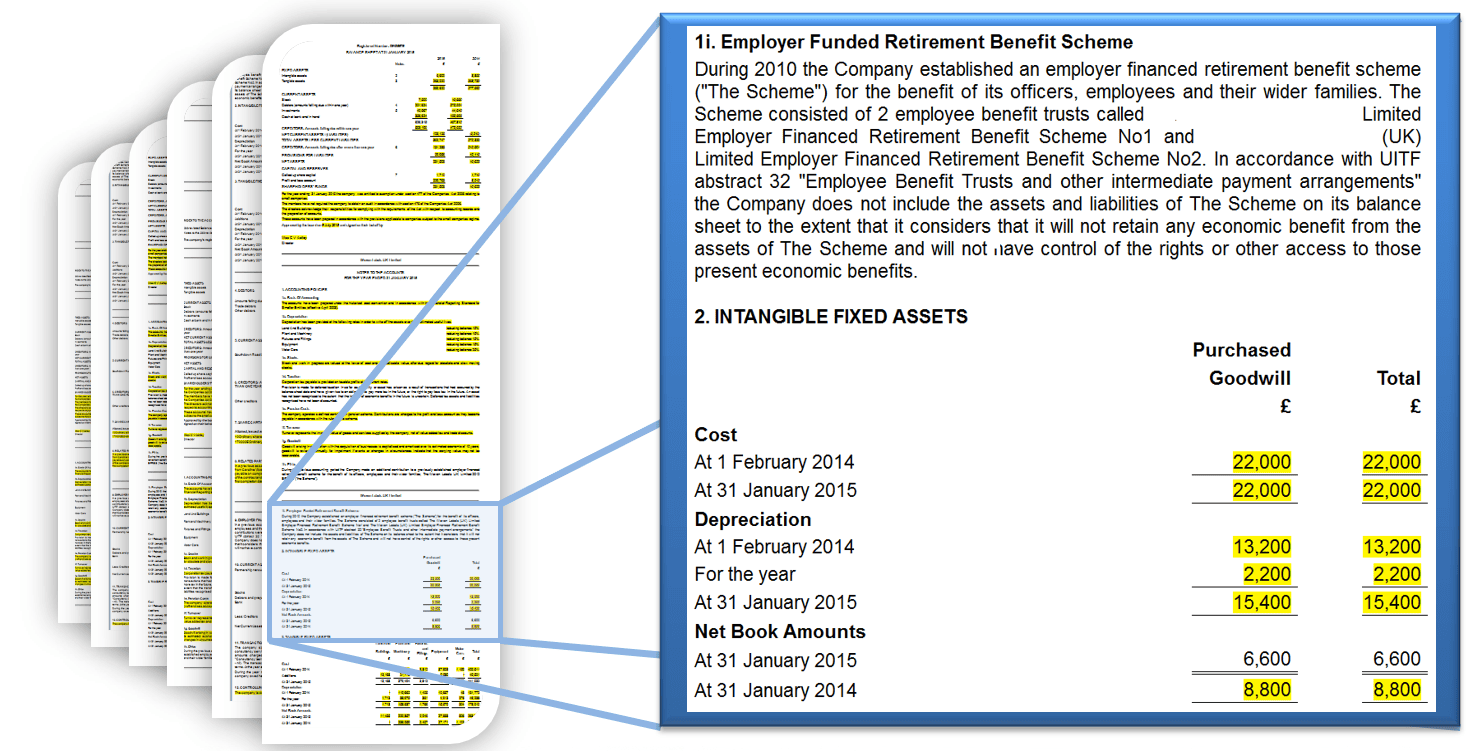
CoreFiling invented the iXBRL format used in ESEF and have more than a decade of experience helping organisations, small and large, to produce tagged documents.
This post is to share some of our knowledge on what tagging is and how to do it right.
Understanding CSRD Tagging
More than 80% of all reports using the ESEF digital format are currently created using a bolt-on tagging process. This starts with a completed report in a PDF, Word, Excel or InDesign format (e.g. EPUB) and ends with an ESEF-compliant iXBRL document, ready for submission.
Tagging generally uses the following process:
1. A completed report in a PDF, Word, Excel or InDesign
2. Conversion to HTML
3. Adding computer-readable tags
4. Validation
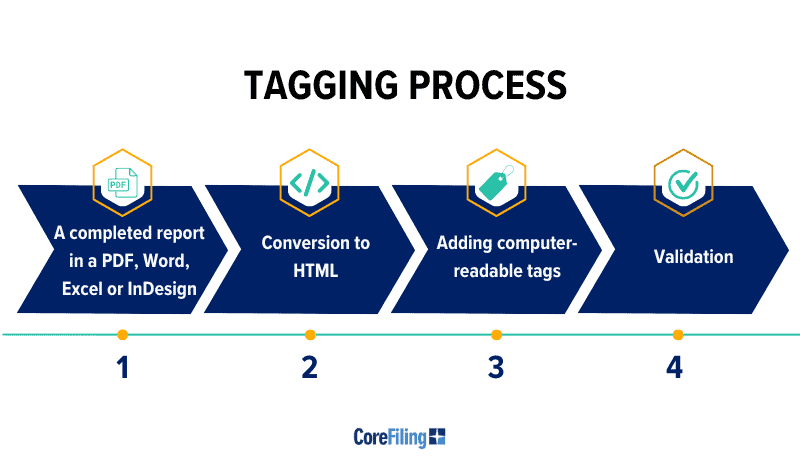
Bolt-on tagging is attractive as it enables companies to keep other reporting processes unchanged while still meeting all the mandatory requirements. Tagging solutions are differentiated by the ease with which the process can be achieved and the quality of the output. Quality is measured in the visual correctness of the report, when compared to the original, and the accuracy of the electronic tags. Both are important to comply with the regulation and to pass audit and submission checks.
With conversion and validation being almost universally automated, most of the time required to prepare an ESEF report for publication is in the “Adding computer readable tags” step. Every number, amount, table, paragraph, date and name that makes up part of the CSRD disclosure must have the correct tag applied. An average report may have around 100 tags while complex reports for large companies could have several hundreds or more.
The European Sustainability Reporting Standards (ESRS) and Article 8 XBRL Taxonomies
Two XBRL taxonomies are relevant to CSRD reporting. The ESRS covers sustainability reporting and Article 8 covers the company’s alignment to green activities.
The ESRS define the disclosures required for material impacts according to a company’s double materiality assessment. The digital version of the ESRS is captured in an XBRL taxonomy and, much like a taxonomy you might find for plants or animals, organises all the available disclosures into an easy-to-use structure.
Each section of the ESRS has a corresponding section in the taxonomy, for example we can see the digital disclosures related to ESRS E3, Section 3 in the screenshot below. The tags listed here capture all the information that needs to be reported for “Targets related to water and marine resources”.
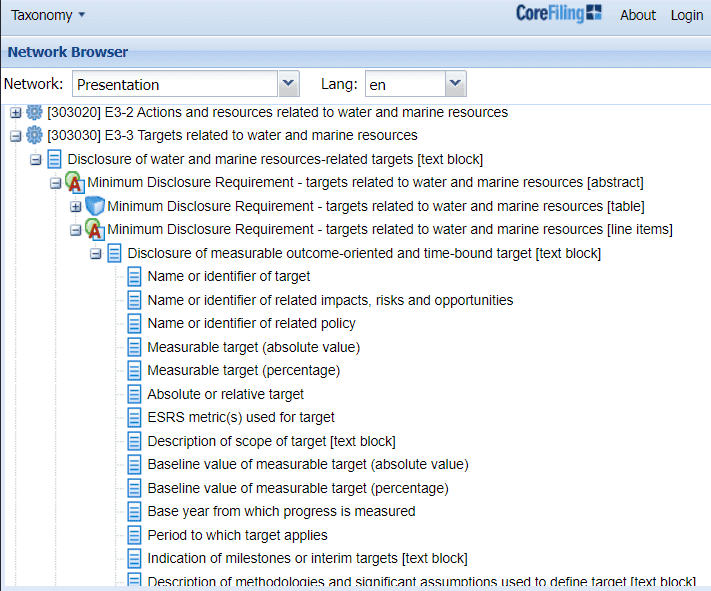
The taxonomy contains a complete list of all the tags that are available for reporting from all of the ESRS, often with a one-to-one relationship. Tags usually fall into one of four categories:
- Process descriptions;
- impact, risk and opportunities (IROs);
- policies, actions and targets (PATs); and
- metrics.
As well as listing all the tags, the taxonomy is also recommended to be used as a guide to laying out the presentation of the report. The ordering of sections and the content of the sections can be copied directly from the taxonomy.
Similarly, the Article 8 taxonomy defines the data points that must be reported by those in scope of these disclosures. Those currently subject to the Non-Financial Reporting Directive (NRFD) will have to report both.
To view either taxonomy you need special software. A taxonomy viewer will often be part of a tagging solution and CoreFiling provide one free to use for hundreds of XBRL taxonomies in use today, including the latest ESRS and Article 8 definitions. The community viewer can be accessed at bigfoot.corefiling.com.
Over time, the taxonomies can be expected to evolve, to fix issues and keep up-to-date with changes to the standards and the needs of report consumers. There is a major change already planned: additional tags for sector-specific reporting will be added to the ESRS taxonomy in 2026.
Applying a Tag
The conversion of the original document into HTML and the final validation is usually carried out automatically with no additional input from the user. The tagging itself is also able to be automated in several ways, but it is useful to start with an idea of how a manual tag is created.
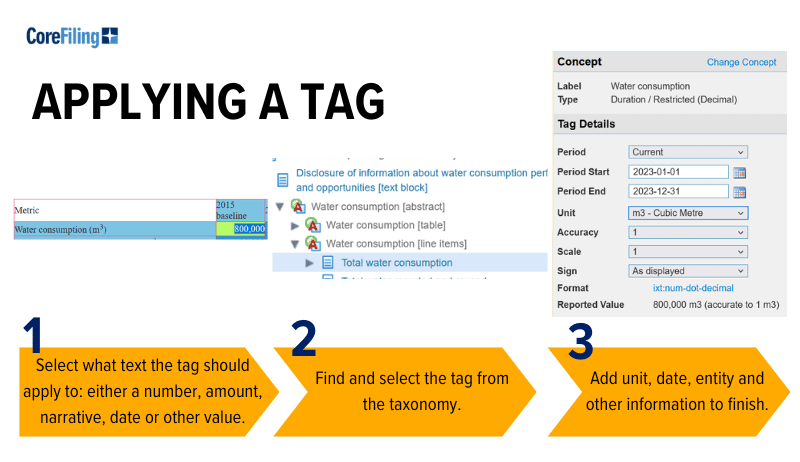
A Closer Look at the Seahorse Tagging Solution
At CoreFiling, we recognised early on that manually applying every tag in a report would be a laborious and tedious process, so much so, that errors would start to creep in. This is why there are several methods provided in our Seahorse tagging solution to speed up the process:
- Fuzzy Search: The most basic enhanced feature is a fuzzy search which allows you to quickly find a tag within the taxonomy by entering keywords. “Fuzzy” means that the words do not need to be exact in order to find what you are looking for.
- The AI Assistant: A much more advanced feature is the AI assistant which uses machine learning to suggest tags for selected text based on prior tagging decisions. This not only speeds up tagging, but promotes consistency between reports.
- Auto-Tagging: With auto-tagging, Seahorse will take each line item and automatically make calls to the AI assistant to create suggestions for entire tables. The confidence of the suggested tags is shown and, in most cases, the entire table can be accepted with a single click.
- Automatic Context: Units, dates and entity information are all entered automatically based on information provided up front and information on the page (such as currency symbols).
- Report Roll-forward: Once you have created an annual report, our roll-forward process allows you to copy the tags applied for second and subsequent years so you only need to work on new areas of reporting. The same process makes it easy to make last minute changes to the report without having to redo tagging.
Some companies choose to tag their own reports, however, it is becoming more common to use specialist tagging services. These benefit from the experience and learnings of doing tens, hundreds or thousands of reports a year and can be very cost-efficient. CoreFiling has a number of partners that provide consistent and fast tagging for reports of any complexity.
While there are lots of ways to take the sting out of tagging, it is important to note that AI, auto-tagging and full service offerings do not reduce the responsibility on the company for the tagging that has been applied. The reporting company must own the tagging decisions and Seahorse provides a review spreadsheet for exactly this purpose along with a full audit trail and commenting features to track decision making.
Key Features of CSRD for Digital Tagging
CSRD digital tagging, iXBRL and the ESRS taxonomy can seem a little daunting at first, but it is worth remembering that these have been designed to be used by reporting teams, not IT experts. Below is a list of key features to help you find your feet with the CSRD reporting requirements:
Alignment of the XBRL Taxonomy with the ESRS
One of the most liberating things to recognise when gaining an initial understanding of digital tagging is that the taxonomy is laid out exactly as the ESRS in text form. Not only that, but it reflects the exact layout expected of CSRD reports.
The taxonomy is presented as a tree or hierarchy. There is a top level for each section of the ESRS and the individual disclosures are laid out beneath this. Headings are used to make it easier to navigate and some tags can be expanded to find sub-totals or more specific disclosures.
Anti-Greenwashing
It has been known for some time that narrative disclosures can be written to leave an impression that something is better than it actually is. In sustainability reports, this is known as greenwashing and can make it hard to distinguish a company making a genuine effort to address sustainability issues from one with a talented author.
Several tags in the taxonomy are provided to counter this practice and better communicate key disclosures. Known as semi-narrative disclosures, these disclosures are simple yes or no answers alongside the narrative text. An example is shown below where a sequence of yes/no tags are used to provide yes or no answers about whether company policies handle specific social sustainability matters.
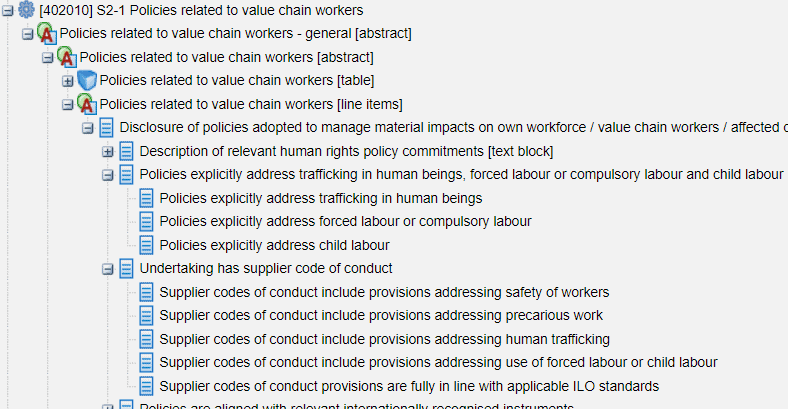
Linking of Impact, Risk and Opportunities (IROs) and Policies, Actions and Targets (PATs)
For IROs and PATs, proper disclosure require links between related items. This means, for example, that you can see which policies are designed to have an impact on which targets.
The ESRS taxonomy provides a special linking mechanism for these tags – known technically as “typed dimensions”. Linked IROs and PATs will have the same value for the typed dimension meaning that the relationships between them can be sensibly extracted from the report.
This type of detail is where tagging can become more complex. In our view, it is up to software to present technical detail like these linking mechanisms in an easy to comprehend way, free of the technicalities and this is what we do.
Tagging to meet Sustainability Reporting Requirements
The general principle for CSRD tagging is that all sustainability information should be tagged. Some headings and “page decoration” such as page numbers, headings and images do not convey useful sustainability data and do not need tags. The main content, however, should be closely aligned with the ESRS with all appropriate tags added. Untagged content related to sustainability performance is highly likely to raise questions at the audit or later stage.
Tags must be accurate and applied correctly. The impact of incorrect tagging when the reports are being consumer is obvious, however, worse is that the company may be seen to be providing misleading information. One of the key audit-related checks for digital disclosures is the accuracy of tags where they use their expert knowledge and exposure to lots of reports to highlight potential inaccuracies.
Implementing Tagging of Sustainability Information
Implementing tagging does not need to be a complex task, below are some simple steps to prepare for digital reporting in your business:
- Familiarise yourself with the ESEF format. Thousands of examples are available to help understand the nature of tagging and the final result.
- Align to the ESRS taxonomy. The closer your report is to the taxonomy, the easier tagging will be. Start by exploring the taxonomy with our community taxonomy viewer.
- Socialise the knowledge within your company. So people are aware of what needs to be done and suitable budget can be made available.
- Procure licences for software if you want to do your own tagging or sign up with a tagging provider for a managed service. In both cases, an independent assurance provider will also need to be selected to provide assurance of the applied tagging.
- Make changes to your annual report. Take advice from your tagging solution provider on how to achieve the best results and make tagging easier. If you use a template, this is a good opportunity to update it and make tagging easier. Further changes may be required to meet accessibility requirements. These changes are also likely to make tagging easier.
- Ensure enough time, not just for tagging, but also for the auditors to feedback on the tagging, and to process any audit findings ahead of finalising the report.
- Track and adjust. Changes should be expected periodically, including the introduction of sector-specific reporting in 2026. Your solution provider may help and CSRD is one of several reporting programmes that CoreFiling track in our LinkedIn posts.
Benefits of CSRD Tagging
The use of machine-readable reports to convey sustainability information is a key part of the CSRD reporting framework. By tagging, data from large numbers of companies is made easily available for anyone to draw down, extract and analyse. Tagged sustainability data is less likely to sit unused in a business registry or be only picked up by specialist companies with lots of resources.
You can expect to benefit directly from the digital aspect of CSRD. When preparing your report a digital set of tags makes it much easier to see what needs to be reported and how. Once prepared, you will be able to benchmark against your peers and gain insight into the whole market.
Challenges and Solutions in CSRD Tagging
The ESEF format itself is the first challenge for EU companies and requires specialist software to create. The “bolt-on” tagging approach is the most common method to prepare an ESEF formatted report. With this approach you do not need to invest in complex reporting tools and can write in Word, PDF or other format and then tag afterwards.
Taking the tagging route, initial conversion is the next challenge. If your annual report has been tweaked and adjusted over several years, you will likely benefit from being tidied up and simplified. Your tagging provider can advise on how to achieve the best result.
Selecting the correct tags is the next challenge, machine learning can help with this, but it is almost always better to ensure that your management report is prepared in line with the ESRS XBRL taxonomy to make it plainly obvious which tags should be applied.
In some places the taxonomy author does not know exactly what will be reported and they leave a place for “entity-specific disclosures” to be made, for example there may be sustainability risks or metrics very specific to your company. This also must be tagged and to do so the new element must be added to the ESRS taxonomy using an “entity specific extension”. The ease with which an entity-specific disclosure can be added is a key differentiator in tagging software.
Remember you are responsible for your report, not the tagging service or software provider. So, make sure you find out what is available to help you review tagging as part of your solution selection process. This should be added to your internal controls to document judgement decisions and provide an audit trail for tagging.
Your overall compliance is paramount so you can file successfully first time. Tagging services exist to help you through this and are usually cost-effective means of getting things correct with minimal effort. The first step in selecting a solution should be to look for XBRL certification which provides a minimum level of assurance that the solution will produce a compliant report.
Future of CSRD Tagging
When the first digital reporting programmes were introduced over a decade ago, it was thought that tagging would be quickly superseded by new report production processes. However, the use of tagging has endured as a cost-effective and simple means to meet reporting obligations.
CoreFiling continue to invest in tagging for the benefit of our customers and look to improve in two main areas. Firstly, to improve the tagging experience through increased use of automation and AI, and quality of life improvements to our software, based on customer feedback. Secondly, finding ways to help companies transition to a tagging-free report preparation through integration with our partners’ disclosure management, accounting and ESG management software.
How Can We Help
CoreFiling make our tagging software “Seahorse” available through our partner network. Our partners are selected companies who provide local support to companies and are fully backed by CoreFiling’s software and expertise. Whether you want to develop digital reporting skills in-house, use a managed service, or are not sure, contact us to be put in touch with the best partner for your needs.
Frequently Asked Questions (FAQs)
Below are some answers to frequently asked questions on CSRD tagging.
What is CSRD Tagging?
CSRD tagging is the process of adding digital tags to CSRD disclosures in your annual financial report. The tags are invisible when the report is being read in a browser and can be extracted by computers for analysis and processing.
Why is a Tagging Solution Important?
A software tagging solution is the only practical means of applying tags to a report.
Self-service solutions give you access to tagging software and you apply your own tagging. Managed services are accessed through a tagging service provider who will take your original report and deliver a fully tagged version in ESEF format for you to review.
How can Businesses Effectively implement CSRD Tagging?
Initial learning should cover the ESEF format and the ESRS data standards, including the ESRS taxonomy. The learning should be socialised in your company so that everyone understands what needs to be created and how.
Tagging solutions will need to be procured and fitted into your reporting process. Once you know how you will produce your CSRD report, you can ask your service provider for advice on changes to make tagging easier. Processes and controls around tagging should be put in place and documented.
Following the first year, the ESRS data standard should be tracked for updates just like other accounting standards.


